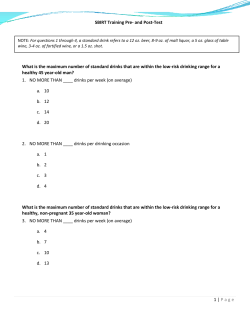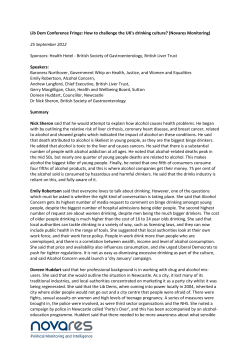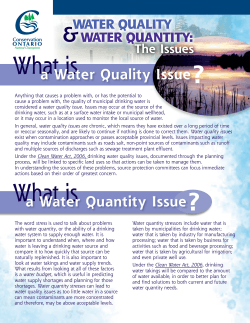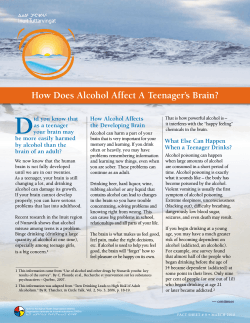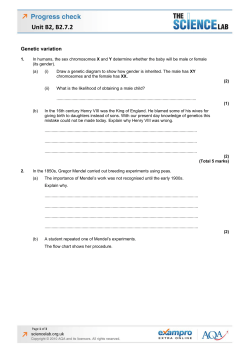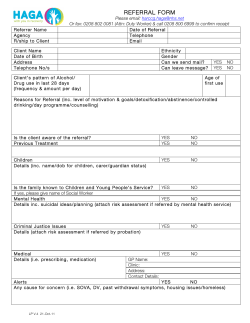
Aromolaran (17)
631 Ife Journal of Science vol. 15, no. 3 (2013) EFFECT OF MORINGA OLEIFERA SEEDS ON BACTERIAL QUALITY OF DRINKING WATER IN RURAL COMMUNITIES OF ONDO SOUTHWESTERN, NIGERIA Aromolaran, Olukemi Department of Biological Sciences, Wesley University of Science and Technology, Ondo, Nigeria kemiaromolaran@gmail.com (Received: April, 2013; Accepted: October, 2013) ABSTRACT The physicochemical and bacteriological quality of drinking water in the rural communities of Ondo was examined and treated with the seeds of Moringa oleifera. The water samples were analyzed for some physicochemical parameters and pour plate technique was used to determine the presence of bacterial pathogens. Multiple tube fermentation technique was used for the determination of Most Probable Number, after which the water samples were treated with Moringa oleifera seeds for two hours. Bagbe and Uleon streams had unpleasant odour, while streams of Aba Titun, Otasan and Igburowo were odourless. All the water samples were within the temperature range of 26oC-27oC and pH range of 6.61-7.27, but were all turbid except the water from Aba Titun. The pathogens that were identified from the water samples include: Escherichia coli, Staphylococcus aureus, Bacillus subtilis, Serratia sp. and Salmonella sp. The treatment significantly reduced the turbidity by between 50 and 66%. The colony forming unit per milliliter of all the water samples exceeded the standard limit of 1.0×102 /ml for drinking water (WHO) but the treatment profoundly decreased the total viable count by between 54.3 and 96.2%. The total coliform count was also reduced by between 56.6 and 100%. The presence of bacterial pathogens in drinking is of public health concern as they may cause gastro-intestinal water borne diseases. Moringa oleifera seeds serve as a low cost, efficient and effective treatment for drinking water, especially for the rural communities, where there is poor access to potable water. Key words: Drinking Water, Moringa oleifera, Microbial Quality, Water Treatment, Ondo INTRODUCTION According to the World Health Organization and UNICEF, over one billion people worldwide do not have access to safe, drinkable water and about forty percent of the world's population lack basic sanitation (Willey et al., 2008). Unavailability of safe drinking water in many developing countries poses a great treat to health, economic productivity and quality of life of the people (Ishaku et al., 2011). A preliminary investigation revealed that a large percentage of rural dwellers in Nigeria do not have access to safe drinking water. They depend largely on surface run-off such as streams, rivers, ponds and unprotected wells (Ishaku et al., 2011; Shittu et al., 2008). Water supplies from these sources are usually contaminated with organic, inorganic and microbial impurities (Edema et al., 2001; Shittu et al., 2008). These water sources are susceptible to water borne diseases such as typhoid fever, cholera, dysentery etc. (Ishaku et al., 2011). Many infectious diseases are transmitted by water through the feacal oral route. Five million children die annually from diseases contracted through drinking water and one sixth of the world population is sick (Bauwer, 2013; USEPA, 2005). The treatment of this poor drinking water is of primary concern, particularly in the rural areas. Improved adequate safe water supply will lead to reduction of human suffering, increased productivity capacities that at the end will reduce health care cost (Ishaku et al., 2011). Since good quality water is not available, treatment with chemicals is expensive, inaccessible to the villagers and chemical treatment could also cause some diseases such as cancers. Biological treatment is considered the most cost-effective and the safest. Moringa oleifera belong to the family Moringaceae (order Brassicales) and is cultivated across the tropics. The seed is edible and has some medicinal uses. The plant is commonly called 'Horse-radish tree' (Ambi et al., 2011). Earlier studies have found Moringa oleifera seed to be non-toxic and recommended for use in developing countries (Ayotunde et al., 2011). The leaves, seeds, flowers and immature pods of this tree are edible and they form a part of traditional diet in many parts of the tropics (Anwor and Rashid, 2007). The leaves are 632 Aromolaran Olukemi: Effect of Moringa Oleifera Seeds on Bacterial Quality of Drinking Water good source of protein, vitamin A, B and C and minerals (Dahot, 1988). The dry seed suspension has coagulation properties and it is use in place of alum to reduce turbidity in Nile water (Muyibi and Evison, 1994). The seed has been used as natural coagulant in the Sudan and other part of Africa (Eilert et al., 1981; Olayemi and Alabi, 1994). Moringa oleifera has proven to be one of the most effective primary coagulants for waste water treatment (Madsen et al., 1987). The seeds of Moringa oleifera have been used effectively to clarify highly turbid water with 90-99 percent of the bacteria removed (Sutherland et. al., 1990). The coagulation properties of Moringa oleifera have been found effective in clarifying turbidity of raw water (Oluwalana et al., 1997). The active agent, 4(4-O-acetyl-á-L-rhamnopyranosyloxy) benzyl isothiocyanate in Moringa oleifera was isolated by Eilert et al. (1981) and identified as an active antimicrobial agent which is readily soluble in water and is non-volatile. The aim of this study was to determine the bacterial quality of drinking water available in some rural areas in Ondo, Southwestern Nigeria and to determine the effect of Moringa oleifera seeds treatment on drinking water before recommendation for use in these rural communities. MATERIALS AND METHODS Study Area Ondo State has eighteen local government areas out of which three were used for this study. The local government areas considered for this study are: Ile Oluji/Oke Igbo, Odigbo and Ondo East. ° ° The state lies between latitude 5 45´ and 7 52´N ° ° and longitude 4 20´ and 6 05´E. The land area is 3 about 15,500km with estimated population of 3,440,024. Collection of Water Samples Water samples were collected from various streams at different locations in rural communities within the three local government areas (Ile Oluji/Oke Igbo, Odigbo and Ondo East) in the State. These streams are the main source of drinking water in these rural communities. The water samples were collected at the users' fetching point into 1.5L sterile bottles and were transported to the laboratory in ice-bag for analysis. Physicochemical Analysis The physicochemical analyses that were carried out include the determination of temperature, pH, turbidity, odour, presence of particles, nitrite and chloride using the standard methods for water analysis (Ademoroti, 1996). Bacteriological Analysis Bacteriological analyses were determined as described by Shittu et al. (2004). Pour plate technique was employed in determining the colony-forming units (cfu/ml) on Plate Count Agar (Oxoid) and bacterial colony was done in triplicate. The presence of coliform was deter mined by Most Probable Number techniques. The result obtained was compared with FAO standard for the estimation of coliform per 100ml of water sample (FAO, 1990). Confirmatory tests were then carried out on positive MPN tubes to confirm the presence of E. coli. Pure colonies obtained by streaking on nutrient agar plates were subjected to some biochemical tests and further characterized by using Bergey's Manual of Determinative Bacteriology (Sneath, 1986). Treatment of Water Samples Mature seeds of Moringa oleifera plant were removed from the pods and the seed coats were removed to obtain clean seeds. Equivalent of one seed weight (0.3g) was used to treat a litre of water sample. The seeds were crushed into fine powder using mortar and pestle. The fine powder was mixed with a small amount of sterile water to form a paste. The paste was then mixed with 250ml of sterile water and was shaken for one minute to activate the coagulant property of the seed. The solution was filtered through a fine muslin cloth into the water sample to be treated. The treated water sample was stirred rapidly for one minute, then left to rest for two hours. The particles and contaminants settled at the bottom and the purified water was carefully poured into sterile container. 20ml of the treated water samples were taken for analysis to determine the efficiency of the treatment (Folkard et. al., 1999). RESULTS AND DISCUSSION The physical properties of the water samples examined are presented in Table 1. The unpleasant odour in Sample A and E could be as a result of Aromolaran Olukemi: Effect of Moringa Oleifera Seeds on Bacterial Quality of Drinking Water feacal disposal along the channel of the stream and poor hygienic condition of the stream. All the samples were characterized by the presence of particles and colour except sample D which was in good hygienic condition. The chloride content of the water sample ranged from 7.19- 17.72mg/l while the nitrate content ranged from 2.37- 13.37mg/l. The high level of nitrate in Aba-Titun stream might be due to agricultural run-off. Fig. 1 shows the pH of the water samples which were within the World Health Organisation recommended level for potable water, ranging from 6.5-8.5(EPA, 2002; WHO, 2004). The turbidity of the water shows the presence of disease causing microorganisms, organic matter and dissolved salt (Shittu et al., 2004). Moringa oleifera seeds reduced the turbidity of the water sample from between 50 and 66.6% (Fig. 2). Sample D shows no turbidity, which conforms to the standard of drinking water (EPA, 2002; World Health Organization, 2004). Table 2 shows the result of the bacteriological analysis of the water samples. The total viable count for all water samples were quite high ranging 4 4 from 0.06×10 cfu/ml to 1.95×10 cfu/ml. Stream A has the highest microbial load of 4 1.95×10 cfu/ml, while that of stream D has the least value. The high microbial count in stream A is due to high discharge of human waste along the channel. The seeds of Moringa oleifera were very effective in reducing the microbial load in all the water samples with the percentage reduction ranging from 56.6-100%. In a related study, Madsen et al. (1987) reported that the seed caused turbidity reduction of 80-99.5% and bacterial reduction of 90-99.9% within the 1-2 hours of treatment. The reduction of the microbial population in the water samples may be due to the presence of the active agent, 4-(4-O-acetyl-á-Lrhamnopyranosyloxy) benzyl isothiocyanate in Moringa oleifera seeds, which binds to charged particulates in the water and settles at the bottom to form flocs (Folkard et al., 1999). The treated 633 water can be decanted and the sediments pouredoff. The Most Probable Number (MPN) for presumptive total coliform count was high except the water sample from Aba-Titun. The total coliform counts for all the water samples were high when compared to EPA Maximum Contamination Level (MCL) for coliform bacteria in drinking water of zero total coliform per 100ml of water (EPA, 2002). The high number of coliforms implies feacal contamination of the water samples (USEPA, 2005) and poor hygienic practices associated with local communities (Shittu et al., 2008). The seeds of Moringa oleifera have been effective in reducing the coliform count from between 64.3% and 96.2%. The bacteria species identified from the water samples include Escherichia coli, Staphylococcus aureus, Bacillus subtilis, Serratia sp. and Salmonella sp. (Table 4). The primary sources of these bacteria in water are animal and human wastes. Most of these bacteria have been isolated from community drinking water supplies in Nigeria (Edema et al., 2001; Inyang and Aderemi, 2001). The bacteria species have significant health implications (WHO, 2004). These bacteria have also been implicated in outbreak of waterborne diseases in some parts of the country (Onuh and Gonchi, 1998). The presence of E. coli in all the water samples signifies feacal contamination (EPA, 2002; Shittu et al., 2008). The results of this preliminary study have shown that the quality of drinking water in some rural communities in Ondo is poor and that the seeds of Moringa oleifera are effective for water purification in the study area, hence it can serve as an alternative natural source of water purification in the rural communities of Ondo, where there is poor access to potable water. There is need for further studies to determine the interaction of the seed with other substances in the water sample. 634 Aromolaran Olukemi: Effect of Moringa Oleifera Seeds on Bacterial Quality of Drinking Water Table 1: Physicochemical Analysis of the Water Samples Samples Parameters Odour Colour Particle Temp. pH Turbidity *Chloride *Nitrate (0C) A unpleasant Slightly present 260C 6.7 0.04 11.97 2.37 present 270C 6.5 0.04 17.71 7.68 present 0 26 C 7.3 0.06 10.06 11.48 turbid B C odourless odourless cloudy Slightly turbid D odourless colourless none 270C 6.7 0.00 11.98 13.37 E unpleasant Slightly present 270C 6.6 0.06 7.19 9.59 6.5-8.5 0.00 250 10 turbid WHO odourless colourless none Keys: A-Bagbe;B-Igburowo;C-Otasan;D-Aba-titun;E-Uleon *-mg/l Fig.1: Effect of Treatment on pH of Water Sample Fig. 2: Effect of Treatment on Turbidity of Water Samples Aromolaran Olukemi: Effect of Moringa Oleifera Seeds on Bacterial Quality of Drinking Water 635 Table 2: Bacteriological Analysis of Water Samples Sample Total Coliform Count code Untreated Treated Total Viable Count % Untreated Treated Reduction % Reduction A 1.95×104 0.1×104 94.9 9.9×103 4.3×103 56.6 B 0.44×104 0.12×104 72.7 1.7×103 0.6×103 64.7 C 0.14×104 0.05×104 64.3 0.4×103 0.00×103 100.0 D 0.06×104 0.01×104 83.3 0.1×103 0.00×103 100.0 E 0.53×104 0.02×104 96.2 4.5×103 0.00×103 100.0 Keys: A-Bagbe;B-Igburowo;C-Otasan;D-Aba-titun;E-Uleon Table 3: Some Presumed Bacteria Isolated from Water Samples A B C D E Escherichia coli + + + + + Staphylococcus aureus - - + + + Bacillus subtilis + - + - + Serratia sp. - - - + - Salmonella sp. + + + + + Keys: A-Bagbe;B-Igburowo;C-Otasan;D-Aba-titun;E-Uleon (Present +; Absent -) REFERENCES Ademoroti, C. M. A. 1996. Standard Methods for Water and Effluent Analysis. March print and consultancy, Felodex Press Ltd. Ibadan182p Ambi, A. A., Abduraham, E. M., Katsayal, U. A., Sule, M. J., Pateh, U. U. and Ibrahim, N. D. G. 2011. Toxicity evaluation of Moringa oleifera leaves. Int. J. Pharm Research and Innovation. 4: 22-24 Anwar, F. and Rashid, U. 2007. Physic-chemical characteristics of Moringa oleifera seeds and seed oil from a wild provenance of Pakistan. Pak. J. Bot. 39 (5): 1443-1453. Ayotunde, E. O., Fagbenro, O. A. and Adebayo O. T. 2011. Toxicity of aqueous extract of Moringa oleifera seed powder to Nile tilapia Oreochromis niloticus fingerlings. Int. Research J. Agric. Sci. and Soil Sci. 1(4): 142-150 Bauwer, H 2003. Integrated water management st for the 21 century: problems and solutions. Food, Agriculture and Environment. 1: 136-140 Edema M. O, Omemu, A. M, Fapetu, O. M. 2001. Microbiological and Physicochemical analysis of drinking water in Abeokuta, Nigeria. Nigeria Journal of Microbiology 15:57-61 Eilert, U., Wolters, B., Nahrstedt, A. 1981. The antibiotic principle of Moringa oleifera and M. stenopetalla. Planta Medica. 42: 55-61 EPA, 2002. US Environmental Protection Agency, Safe Drinking Water Act Ammendment. Http:www.epa.gov/safe water/md. Html Dahot, M. U. 1988. Vitamin content of seeds of Moringa oleifera. Pak. J. Biochem. 21: 21-24 F.A.O., 1990. Food and Agriculture Organization. Chemical Analysis Manual for Food and Water. th 5 edition 1:20-21 Folkard, G., Sutherland, J. and Shaw, R. 1999. Water clarification using Moringa oleifera seed coagulants. London School of Hygiene and Tropical Medicine, L o u g h b o r o u g h U n ive r s i t y h t t p : 636 Aromolaran Olukemi: Effect of Moringa Oleifera Seeds on Bacterial Quality of Drinking Water www.iboro.ac.uk/well/ Inyang, C. U and Aderemi, A. D. 2001. Bacteriological assessment of drinking water in Makurdi, Nigeria. J. Agric. Sci. and Technol. 13:136-140 Ishaku, H. T., Majid, M., Ajayi, A. P and Haruna, A. 2011. Water supply dilemma in Nigeria Rural Communities: Looking towards the Sky for an Answer. J. Wat. Res. and Protect. 3: 598-606. Madsen, M, Schlundt, J. and Olmer, E. F. 1987. Effect of water coagulation by seed of Moringa oleifera on bacterial concentration. J. Trop.Med. Hygiene 90(3): 101-109 Muyibi, S. A. and Evison, L. M. 1994. Moringa oleifera seeds for softening hard water. Wat. Res. 5(4): 1099-1105 Olayemi, A. B and Alabi, R. O. 1994. Studies on Traditional water purification using Moringa oleifera seeds. African Study Monographs 15(3): 135-142 Oluwalana, S. A, Bankole, W., Bolaji, G. A., Martins, O. and Alegbeleye, O. 1997. Domestic water purification using Moringa oleifera Lam. The Nigerian Journal of Forestry 29: 28-32 Onuh, C. A and Gonchi, L. C. 1998. The incidence of enterobacteriaceae in drinking water from Mangu Local Government Area Plateau State, Nigeria. African Journal of Natural Sciences 2:115-119 Shittu, O. B., Popoola, T. O. S and Taiwo, O. 2004. Potential of Calotropis procera leaves for wastewater treatment. Proceedings of International Conference on Science and National th Development 25 -28. Shittu, O. B., Olaitan, J. O and Amusa, T. S. 2008. Physicochemical and bacteriological analysis of water used for drinking and swimming purposes in Abeokuta, Nigeria. African Journal of Biomedical Research. 11:285-290 Sneath, P. H. A. 1986. Bergey's Manual of Systematic Bacteriology. Williams and Wilkings, Baltimore. Sutherland, J. P., Folkard, G. K and Grant, W. D. 1990. Natural coagulants for appropriate water treatment: A novel approach. Waterlines 8:30-32 USEPA, 2005. List of drinking water contaminants and their maximum contamination levels. United State Environmental Protection Guidelines World Health Organization 2004. Water Sanitation and Health Programme. Managing water in the home: accelerated health gains from improved water resources. World Health Organization. www.who.int Willey, J. M., Sherwood, L. M. and Woolverton, C. th J. 2008. Microbiology 7 edition. McGraw Hill Higher education New York 1050p
© Copyright 2025



